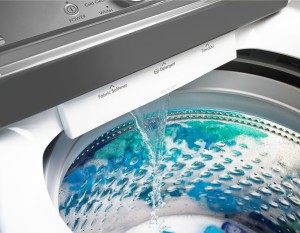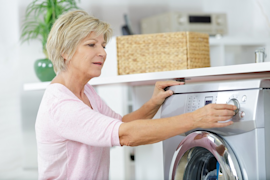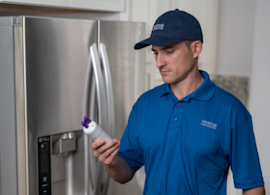6 washing machine tips


With all of the agitating and spinning it does, your washing machine easily is one of the hardest working appliances in your home. The constant movement of the spin basket and outer tub causes a lot of wear, and the wet conditions are a breeding ground for odors and mildew. Keep your washer working well to get your clothes clean load after load—just follow these tips.
Check out our laundry accessories page for products to keep your washer and dryer in tip-top shape. And see our DIY Washer Repair page for troubleshooting videos, step-by-step repair guides and tips on how to keep your washing machine running efficiently.
Clean the wash tub
Once a month, use a washing machine cleaner to prevent detergent residue, lint and dirt from building up, causing odors and bacterial growth in the washer. Some washers have a self-clean cycle; see your owner’s manual for specific instructions on cleaning the tub.
Load washer and set cycle correctly
Both top and front-load washers need room to do their job, which is to clean your clothes. Jamming too many clothes into the wash basket forces your washer to work too hard and leads to your clothes not getting clean. Make sure to set the right cycle and load size, too. Washing a full load of heavy clothes on a setting meant for delicate or small loads won't get your clothes clean, and might leave them too wet to dry in one cycle in the dryer. Not only does that waste time and energy, it adds undue wear and tear on your washer and dryer.
Too many clothes in the wash basket also can throw the washer off balance, as can mixing fabrics of very different weights, like heavy towels with lightweight shirts. If the washer can't fix the imbalance by adding more water, it stops the cycle. When you trudge down to the basement laundry room expecting to find a load ready for the dryer, you instead have to rearrange a heavy wad of wet garments so the washer will finish the cycle.
Imbalanced loads are more than an inconvenience. They’re tough on the shock absorbers that support the outer tub in the washer cabinet. They also beat up the lid switch or even the outer tub itself. If the lid switch on your washer is broken or the lid lock light flashes, replace it using our DIY guide How to replace the lid switch/lock assembly on a top-load washer.
Use the right amount of detergent
Too little detergent won't get your clothes clean, but too much detergent leaves soap residue on clothing and in the washer. This residue could actually hold the dirt that you tried to wash away, meaning your clothes are still dirty. The extra soap in your washer also attracts dirt, leading to a smelly washer.
Too much detergent leads to over-sudsing, which can lock up and damage the drain pump. If you have soft water or use a water softener, reduce the amount of detergent you use, because soft water allows the detergent to produce more suds. Follow the recommendation in your owner's manual for more on detergent use.
Clean the dispensers and pump filter
Liquid fabric softener and laundry detergent can build up in the dispensers, so clean the dispensers once a month following the instructions in your owner’s manual.
If your washer model has a pump filter, clean it once a month as well. Some front load washers have a small door at the bottom of the washer, allowing access to the pump filter. Most of these filters unscrew from the housing so you can remove lint and debris, but check your owner's manual for specific instructions. If there is no access door at the bottom, check out our Cleaning the drain pump filter on a front-load washer with no access door video.
Level the washer
Keeping the machine level prevents excessive noise and vibration, which prematurely wears the washer and causes damage to internal components. To protect these components, the washer control board will stop the cycle if it detects too much vibration.
All 4 legs should make firm contact with the floor. Check the stability of your washer by firmly pressing down on diagonally opposing corners. If there's any rocking, level the machine by adjusting the leveling legs at the bottom.
Loosen the lock nut and rotate the leveling leg clockwise to raise the leg or counterclockwise to lower it. Tighten the lock nut to hold the leg in position when done.
If the machine appears to be level but you still notice vibration noises, add a sheet of ¾-inch plywood under the washer to reinforce the floor.
Inspect the water inlet hoses
Every month or so, check the water inlet hoses and the drain hose at the back of the washing machine and replace them if you find any bulges or cracks. This could save your home from costly damages due to a water leak.
Most common symptoms to help you fix your washers
Choose a symptom to see related washer repairs.
Main causes: unbalanced load, loose spanner nut, worn drive block, broken shock absorber or suspension spring, debris in…
Main causes: bad lid switch or door lock, bad timer or electronic control board, wiring failure, bad water inlet valve a…
Main causes: clogged drain hose, house drain clogged, bad drain pump, water-level pressure switch failure, bad control b…
Main causes: leaky water inlet valve, faulty water-level pressure switch, bad electronic control board…
Main causes: water heater failure, bad water temperature switch, faulty control board, bad water valve, faulty water tem…
Main causes: lack of electrical power, wiring failure, bad power cord, electronic control board failure, bad user interf…
Main causes: no water supply, bad water valves, water-level pressure switch failure, control system failure, bad door lo…
Main causes: worn agitator dogs, bad clutch, broken motor coupler, shifter assembly failure, broken door lock, suspensio…
Main causes: broken lid switch or lid lock, bad pressure switch, broken shifter assembly, faulty control system…
Most common repair guides to help fix your washers
Effective articles & videos to help repair your washers
Use the advice and tips in these articles and videos to get the most out of your washer.

Find tips for using your washing machine efficiently to save energy and help reduce utility bills.…

Learn about all the convenient features on our Sears PartsDirect website that make your parts purchases easier.…

Get answers to frequently asked questions about Sears and Sears PartsDirect.…
